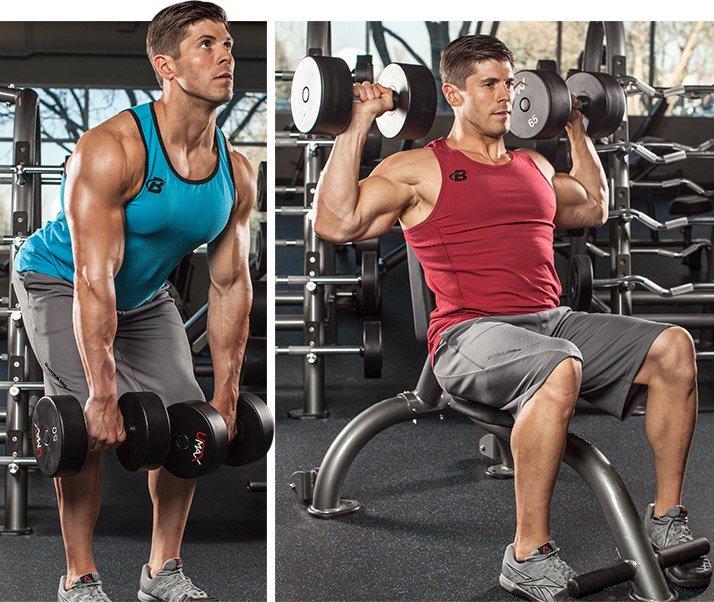
5 Weight-Loss Sins Everyone Makes (And How To Fix Them!)
Embarking on a weight-loss journey? Don't fear the misery of dieting. Instead, learn how to cut these 5 mistakes from your plan and make this your most successful cut yet!
So, you want to lose some weight. Maybe you've squeezed every caloric morsel out of a recent bulk and are ready to switch gears, or perhaps you're just eager to drop some extra or unwanted pounds. You might even have a set number of pounds in mind, which is a great place to start!
When you begin losing weight—fat, not muscle!—through a combination of eating lower calories, exercising, and modifying your lifestyle, things usually start well enough. Excited about the journey ahead, you've got energy for days and are racking up personal achievements like you've hit the jackpot at life's slot machine.
A couple of weeks in, however, one of these things usually happens:
- The scale stops moving and you become unmotivated.
- You do too much and you get burnt out.
- You cut too many calories at once and eventually give the middle finger to your diet.
Weight loss doesn't have to be this way! Quite simply, those are merely the common side effects of dieting too hard with no regard for long-term sustainability. Get out your notebook, save your weight-loss journey, and identify which of these common mistakes you should avoid!
Mistake 1 Training too much
Never is there a more appropriate instance in which the "less is more" rule of thumb applies than when dieting. From a straight calories-in, calories-out perspective, it's very easy to be misled into thinking you must "do more" to lose weight. In this context, doing more could mean more sets, more training sessions, more workout days, more exercise selections—the list could go on forever.
In reality, training too much while in a caloric deficit is like getting a salary reduction when you can barely pay your bills. You're going to be in trouble quickly!

When you're training for weight loss, it is assumed that you are already in a caloric deficit, meaning that your body is already stressed out from inadequate calories for optimal function. When such a stressor is placed upon your body, your ability to recover between workouts and manage the stresses of daily life is compromised.
When you do even more and ramp up the frequency, volume, intensity, or duration of your workouts, you compound the number of stressors your body has to shoulder. The odds of burning out and feeling utterly miserable begin to multiply exponentially. This matters because a bad burnout is how people fall completely off the wagon and regain all of their weight.
The fix
Do the minimal amount of work, or the "minimum effective dose," necessary to get the job done. In my book, you should lift roughly three times per week for 45-60 minutes per session. This may not seem like much, but the entire purpose of training during a fat-loss phase is to remind your muscles why they exist—and why they should stick around!—with short, intense workouts. The remainder of your time should be focused on rest and recovery, which is already somewhat compromised by a caloric deficit.
Mistake 2 Performing targeted isolation work
Targeting very specific body parts has been a long-time practice in bodybuilding circles. It makes sense to show some love to underdeveloped body parts, but there's just one problem: When you're eating at a deficit, you don't have extra calories for building muscle—no extra fuel to build a bigger fire, so to speak.
Performing isolation exercises only taps into limited resources in an already taxed body. The reality is that, without a calorie surplus, you can do curls, skullcrushers, and cable crunches for days, but any measurable muscular gains in those specific areas are pretty much nil. Complete beginners or someone who is returning from a long training hiatus will be exceptions to this rule.

The fix
Focus almost entirely on total-body movements that hit nearly every muscle group, including pulls, pushes, and squats.
Some examples:
- Biceps: Pull-ups, chin-ups, and rows.
- Triceps: Bench presses, shoulder presses, and dips.
- Glutes: Deadlifts, squats, and hip thrusts.
- Abs: All of the above.
Aim for 8-12 total sets of compound movements per session in the 6-12 rep range per set. Keep the isolation stuff for your muscle-building cycles. When cutting fat, focus on training the whole body for maintaining your current levels of strength and size.
Mistake 3 Doing too much cardio

Cardio often gets a bad rap, but mostly because people do too much of it. These people focus far too much on the "calories out" within the law of thermodynamics, which states that energy can be neither created nor destroyed.
Given that law, your fat-loss choices are: consume fewer calories or expend more of them. The gut response is to simply expend more calories while eating less; ergo, that would make the greatest "calories out," right?
This seems sound, but let's not forget what we talked about in the first point: stressors. We need to minimize them as much as possible to prevent burnout. Doing more cardio and activity in general causes a greater stress response.
The fix
Instead of upping your cardio, focus on your diet, which will require some planning and quite a bit of thought. If you have plans to step onto the stage in the near future and are already strikingly lean, cardio might be useful in this case to get rid of stubborn body fat and mobilize free fatty acids. This doesn't apply to most folks, however, so extra cardio isn't a requirement for the most effective fat loss.
Instead, preserve your recovery, your energy, your peace of mind, and your sanity. Plan well, eat well, and rest up.
Mistake 4 Cutting through muscle
Let's face it: Cutting sucks. You have to closely watch your food intake, and you'll probably be hungry a lot of the time. But the results of a good cut? Priceless. What is a good cut? One that eliminates fat and spares muscle, of course!
Given the amount of time and effort you put into building mass, treat the muscle you have earned thus far as extremely sacred. During a cutting phase, you should strive to preserve your hard-earned muscle at all costs, so don't drop your calories too low or cardio your way through it, as many folks do.

The fix
Aim for a slight caloric deficit of 10-20 percent below your maintenance calorie level when starting your cut. There's often no need to get fancy with things like carb backloading, ketogenesis, or protein-sparing modified fasts. Simply get the protein, fats, and carbs necessary to power your training.
Keep in mind that weight on the scale seldom reflects exactly what is happening to your body composition, so don't obsess over getting a lower and lower number. Use the scale in conjunction with other measures—body fat, the mirror, your lifts, and more—to track your true progress. Patience, patience, patience!
Mistake 5 Cutting "too clean"

It makes sense to eat "clean" foods while trying to lose fat; not for any magical fat-loss properties of whole foods, but mainly because they are both nutritionally dense and satiating. Certainly, you will feel fuller eating the same amount of carbs from potatoes than you would from Skittles. (Sorry, Marshawn Lynch.)
However, these benefits can all backfire if your diet is far too restrictive, especially if you're cutting over an extended period of time, like a few months.
The fix
World-renowned nutritionist Alan Aragon is famous for this excellent advice when it comes to nutrition composition on a cut: "You should aim to make your diet 80 percent whole foods you enjoy, 10 percent whole foods you don't enjoy but you know are healthy for you, and 10 percent 'pure junky goodness.'"
How you choose to integrate that "junky goodness" into your diet is your call. Whether it's fitting 2-3 cookies into your macros after dinner each night or a nice pint with the buddies on a Saturday night, use your 10 percent wisely to minimize cravings and maintain dieting sanity.
Remember that heavy food restriction is a sign of an unhealthy relationship with food and can lead to uncontrollable binging episodes, which can really set back your progress and drain your morale.
Cut the Fat
Armed with this simple advice, you should now be ready to embark on—and successfully complete—your weight-loss journey! Have questions or tips of your own? Let me know in the comments below!

